Treasury and Risk Management: SNB De-pegging and Hedging Strategies
VerifiedAdded on 2021/04/24
|9
|1788
|60
Report
AI Summary
This report provides a comprehensive analysis of treasury and risk management, focusing on the Swiss National Bank's (SNB) decision to de-peg the Swiss Franc from the Euro in January 2011. The report delves into the reasons behind the SNB's action, including the accumulation of Euro and foreign currency reserves, and the devaluation of the Euro. It then evaluates various hedging strategies employed by Swiss exporters to mitigate currency risk, including unhedged strategies, forward hedges, money market hedges, and option hedges (both put and call options). The report calculates potential dollar cash flows for each strategy under different spot price scenarios, identifies the risks associated with each approach, and ultimately recommends the optimal hedging strategy for a hypothetical company, ABC. The analysis highlights the benefits and drawbacks of each method, with a money market hedge being identified as the most beneficial approach due to its potential for minimizing losses and maximizing profits under various market conditions. References and bibliography are included.
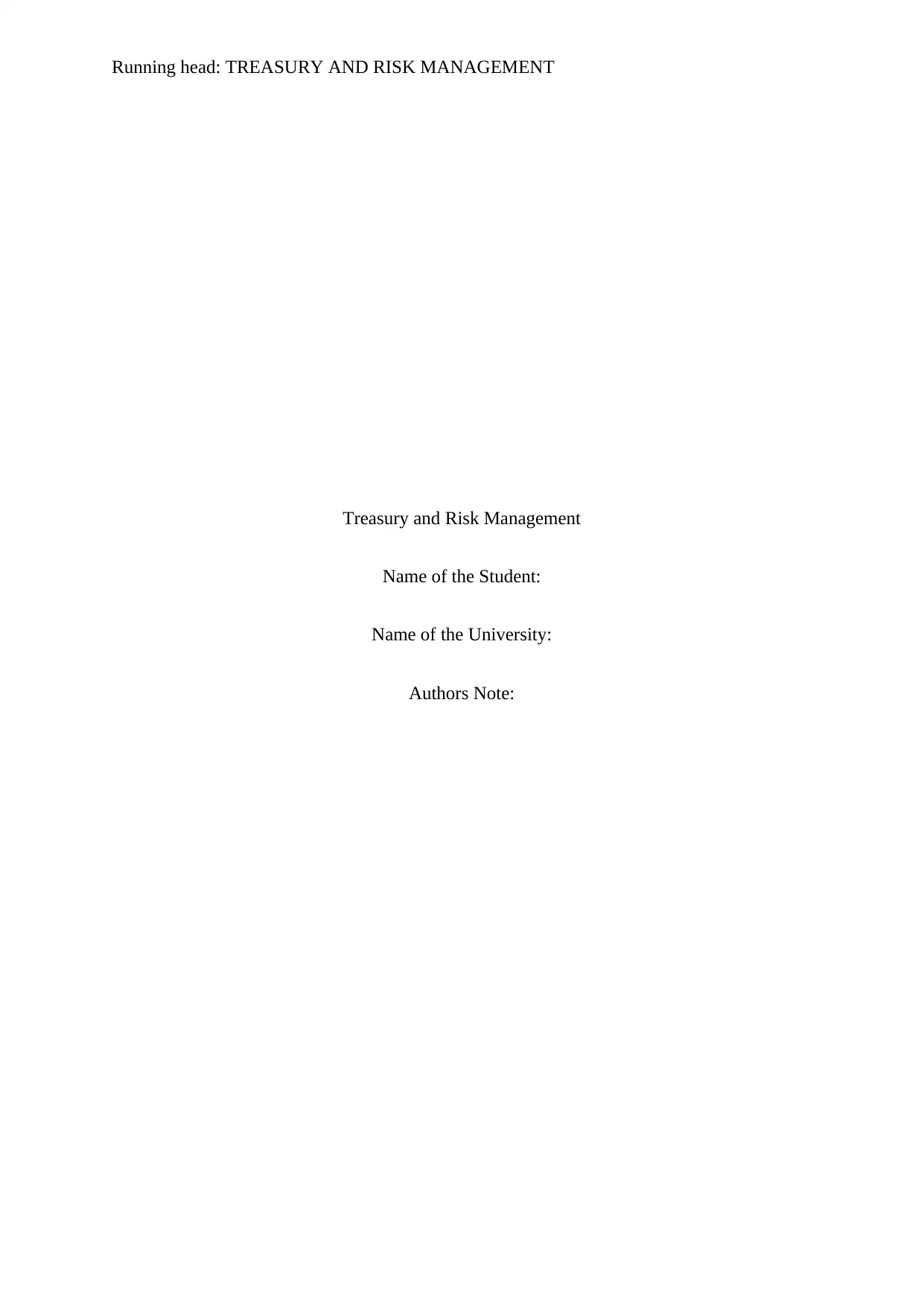
Running head: TREASURY AND RISK MANAGEMENT
Treasury and Risk Management
Name of the Student:
Name of the University:
Authors Note:
Treasury and Risk Management
Name of the Student:
Name of the University:
Authors Note:
Paraphrase This Document
Need a fresh take? Get an instant paraphrase of this document with our AI Paraphraser
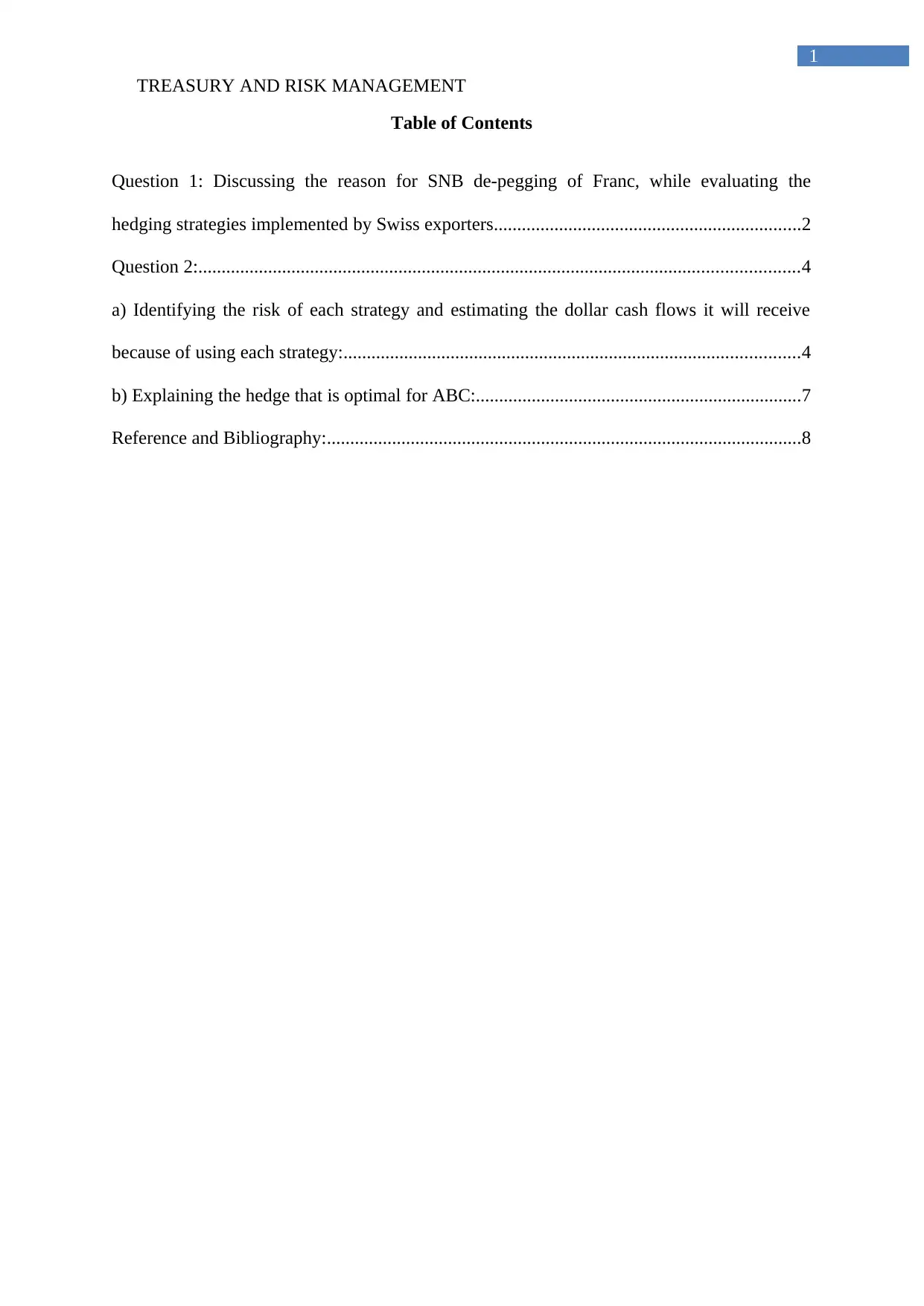
TREASURY AND RISK MANAGEMENT
1
Table of Contents
Question 1: Discussing the reason for SNB de-pegging of Franc, while evaluating the
hedging strategies implemented by Swiss exporters..................................................................2
Question 2:.................................................................................................................................4
a) Identifying the risk of each strategy and estimating the dollar cash flows it will receive
because of using each strategy:..................................................................................................4
b) Explaining the hedge that is optimal for ABC:......................................................................7
Reference and Bibliography:......................................................................................................8
1
Table of Contents
Question 1: Discussing the reason for SNB de-pegging of Franc, while evaluating the
hedging strategies implemented by Swiss exporters..................................................................2
Question 2:.................................................................................................................................4
a) Identifying the risk of each strategy and estimating the dollar cash flows it will receive
because of using each strategy:..................................................................................................4
b) Explaining the hedge that is optimal for ABC:......................................................................7
Reference and Bibliography:......................................................................................................8
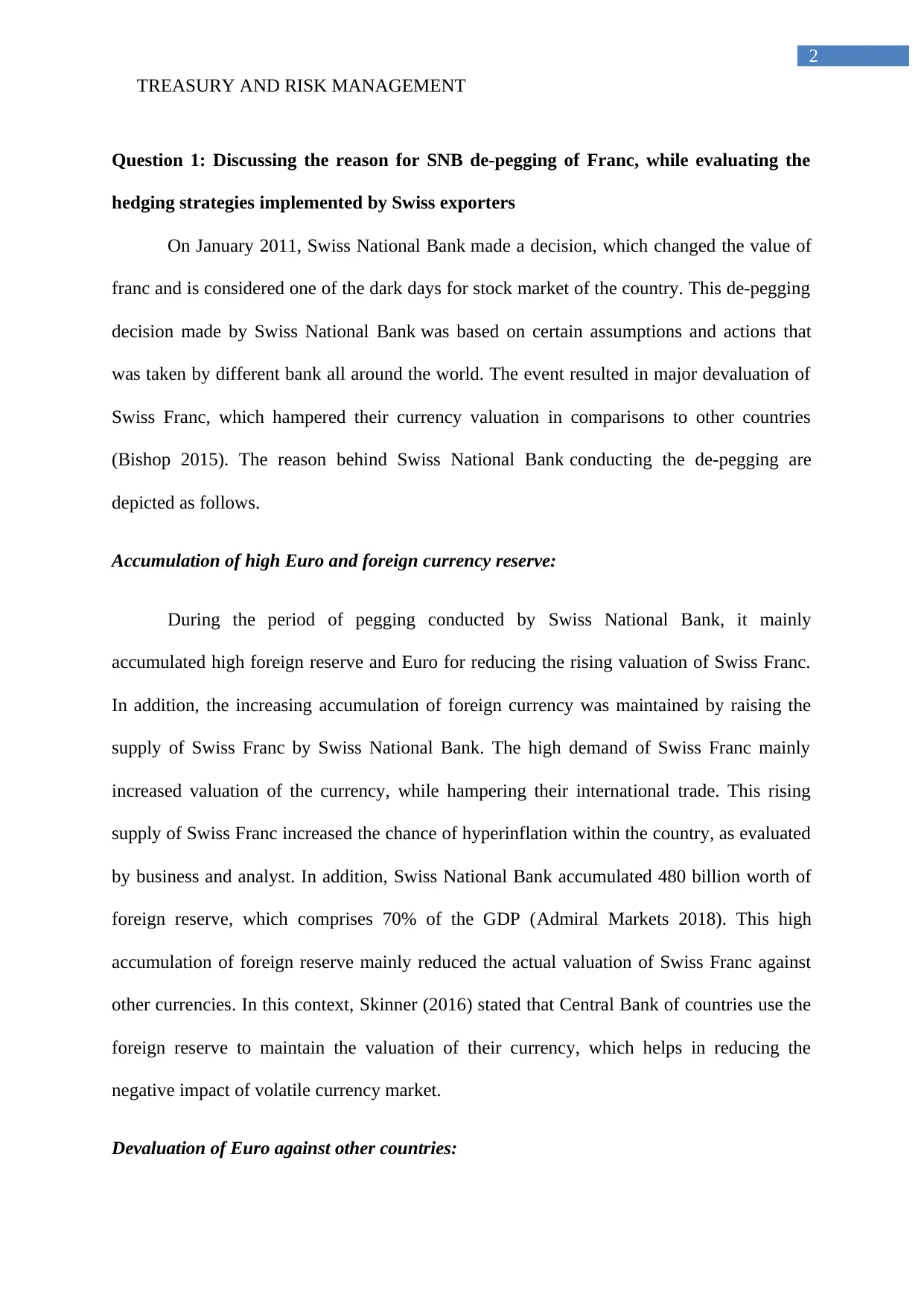
TREASURY AND RISK MANAGEMENT
2
Question 1: Discussing the reason for SNB de-pegging of Franc, while evaluating the
hedging strategies implemented by Swiss exporters
On January 2011, Swiss National Bank made a decision, which changed the value of
franc and is considered one of the dark days for stock market of the country. This de-pegging
decision made by Swiss National Bank was based on certain assumptions and actions that
was taken by different bank all around the world. The event resulted in major devaluation of
Swiss Franc, which hampered their currency valuation in comparisons to other countries
(Bishop 2015). The reason behind Swiss National Bank conducting the de-pegging are
depicted as follows.
Accumulation of high Euro and foreign currency reserve:
During the period of pegging conducted by Swiss National Bank, it mainly
accumulated high foreign reserve and Euro for reducing the rising valuation of Swiss Franc.
In addition, the increasing accumulation of foreign currency was maintained by raising the
supply of Swiss Franc by Swiss National Bank. The high demand of Swiss Franc mainly
increased valuation of the currency, while hampering their international trade. This rising
supply of Swiss Franc increased the chance of hyperinflation within the country, as evaluated
by business and analyst. In addition, Swiss National Bank accumulated 480 billion worth of
foreign reserve, which comprises 70% of the GDP (Admiral Markets 2018). This high
accumulation of foreign reserve mainly reduced the actual valuation of Swiss Franc against
other currencies. In this context, Skinner (2016) stated that Central Bank of countries use the
foreign reserve to maintain the valuation of their currency, which helps in reducing the
negative impact of volatile currency market.
Devaluation of Euro against other countries:
2
Question 1: Discussing the reason for SNB de-pegging of Franc, while evaluating the
hedging strategies implemented by Swiss exporters
On January 2011, Swiss National Bank made a decision, which changed the value of
franc and is considered one of the dark days for stock market of the country. This de-pegging
decision made by Swiss National Bank was based on certain assumptions and actions that
was taken by different bank all around the world. The event resulted in major devaluation of
Swiss Franc, which hampered their currency valuation in comparisons to other countries
(Bishop 2015). The reason behind Swiss National Bank conducting the de-pegging are
depicted as follows.
Accumulation of high Euro and foreign currency reserve:
During the period of pegging conducted by Swiss National Bank, it mainly
accumulated high foreign reserve and Euro for reducing the rising valuation of Swiss Franc.
In addition, the increasing accumulation of foreign currency was maintained by raising the
supply of Swiss Franc by Swiss National Bank. The high demand of Swiss Franc mainly
increased valuation of the currency, while hampering their international trade. This rising
supply of Swiss Franc increased the chance of hyperinflation within the country, as evaluated
by business and analyst. In addition, Swiss National Bank accumulated 480 billion worth of
foreign reserve, which comprises 70% of the GDP (Admiral Markets 2018). This high
accumulation of foreign reserve mainly reduced the actual valuation of Swiss Franc against
other currencies. In this context, Skinner (2016) stated that Central Bank of countries use the
foreign reserve to maintain the valuation of their currency, which helps in reducing the
negative impact of volatile currency market.
Devaluation of Euro against other countries:
⊘ This is a preview!⊘
Do you want full access?
Subscribe today to unlock all pages.

Trusted by 1+ million students worldwide
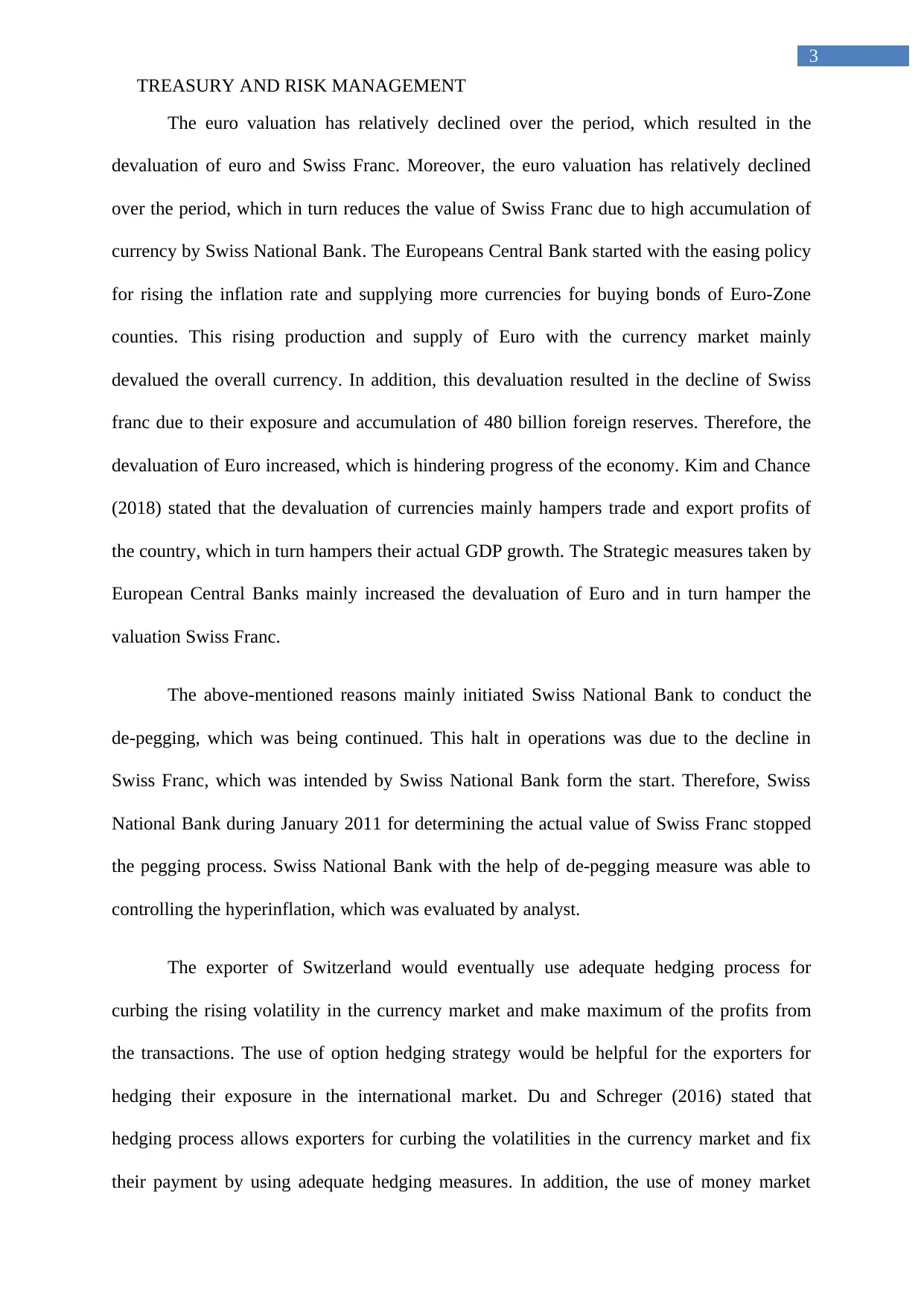
TREASURY AND RISK MANAGEMENT
3
The euro valuation has relatively declined over the period, which resulted in the
devaluation of euro and Swiss Franc. Moreover, the euro valuation has relatively declined
over the period, which in turn reduces the value of Swiss Franc due to high accumulation of
currency by Swiss National Bank. The Europeans Central Bank started with the easing policy
for rising the inflation rate and supplying more currencies for buying bonds of Euro-Zone
counties. This rising production and supply of Euro with the currency market mainly
devalued the overall currency. In addition, this devaluation resulted in the decline of Swiss
franc due to their exposure and accumulation of 480 billion foreign reserves. Therefore, the
devaluation of Euro increased, which is hindering progress of the economy. Kim and Chance
(2018) stated that the devaluation of currencies mainly hampers trade and export profits of
the country, which in turn hampers their actual GDP growth. The Strategic measures taken by
European Central Banks mainly increased the devaluation of Euro and in turn hamper the
valuation Swiss Franc.
The above-mentioned reasons mainly initiated Swiss National Bank to conduct the
de-pegging, which was being continued. This halt in operations was due to the decline in
Swiss Franc, which was intended by Swiss National Bank form the start. Therefore, Swiss
National Bank during January 2011 for determining the actual value of Swiss Franc stopped
the pegging process. Swiss National Bank with the help of de-pegging measure was able to
controlling the hyperinflation, which was evaluated by analyst.
The exporter of Switzerland would eventually use adequate hedging process for
curbing the rising volatility in the currency market and make maximum of the profits from
the transactions. The use of option hedging strategy would be helpful for the exporters for
hedging their exposure in the international market. Du and Schreger (2016) stated that
hedging process allows exporters for curbing the volatilities in the currency market and fix
their payment by using adequate hedging measures. In addition, the use of money market
3
The euro valuation has relatively declined over the period, which resulted in the
devaluation of euro and Swiss Franc. Moreover, the euro valuation has relatively declined
over the period, which in turn reduces the value of Swiss Franc due to high accumulation of
currency by Swiss National Bank. The Europeans Central Bank started with the easing policy
for rising the inflation rate and supplying more currencies for buying bonds of Euro-Zone
counties. This rising production and supply of Euro with the currency market mainly
devalued the overall currency. In addition, this devaluation resulted in the decline of Swiss
franc due to their exposure and accumulation of 480 billion foreign reserves. Therefore, the
devaluation of Euro increased, which is hindering progress of the economy. Kim and Chance
(2018) stated that the devaluation of currencies mainly hampers trade and export profits of
the country, which in turn hampers their actual GDP growth. The Strategic measures taken by
European Central Banks mainly increased the devaluation of Euro and in turn hamper the
valuation Swiss Franc.
The above-mentioned reasons mainly initiated Swiss National Bank to conduct the
de-pegging, which was being continued. This halt in operations was due to the decline in
Swiss Franc, which was intended by Swiss National Bank form the start. Therefore, Swiss
National Bank during January 2011 for determining the actual value of Swiss Franc stopped
the pegging process. Swiss National Bank with the help of de-pegging measure was able to
controlling the hyperinflation, which was evaluated by analyst.
The exporter of Switzerland would eventually use adequate hedging process for
curbing the rising volatility in the currency market and make maximum of the profits from
the transactions. The use of option hedging strategy would be helpful for the exporters for
hedging their exposure in the international market. Du and Schreger (2016) stated that
hedging process allows exporters for curbing the volatilities in the currency market and fix
their payment by using adequate hedging measures. In addition, the use of money market
Paraphrase This Document
Need a fresh take? Get an instant paraphrase of this document with our AI Paraphraser
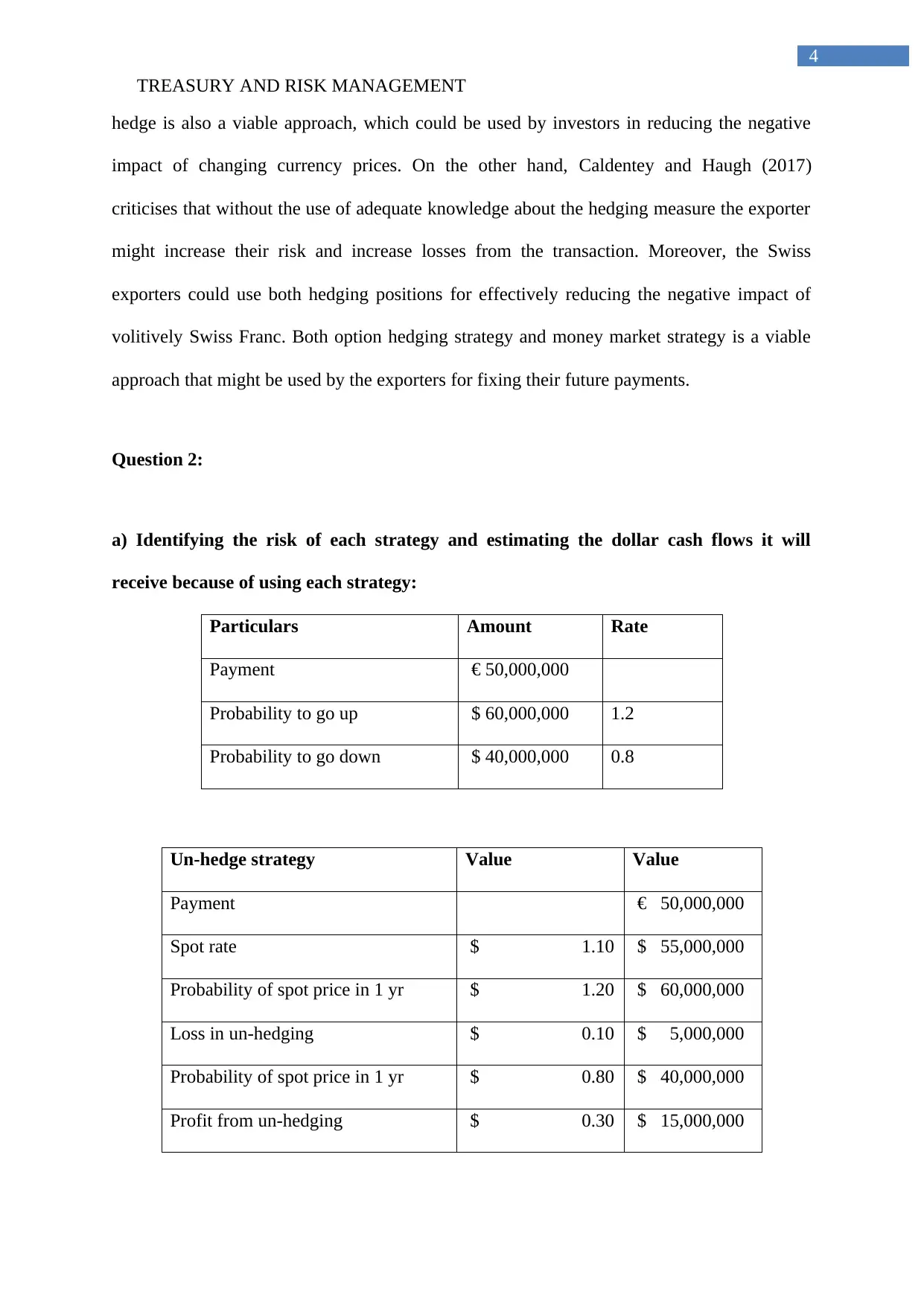
TREASURY AND RISK MANAGEMENT
4
hedge is also a viable approach, which could be used by investors in reducing the negative
impact of changing currency prices. On the other hand, Caldentey and Haugh (2017)
criticises that without the use of adequate knowledge about the hedging measure the exporter
might increase their risk and increase losses from the transaction. Moreover, the Swiss
exporters could use both hedging positions for effectively reducing the negative impact of
volitively Swiss Franc. Both option hedging strategy and money market strategy is a viable
approach that might be used by the exporters for fixing their future payments.
Question 2:
a) Identifying the risk of each strategy and estimating the dollar cash flows it will
receive because of using each strategy:
Particulars Amount Rate
Payment € 50,000,000
Probability to go up $ 60,000,000 1.2
Probability to go down $ 40,000,000 0.8
Un-hedge strategy Value Value
Payment € 50,000,000
Spot rate $ 1.10 $ 55,000,000
Probability of spot price in 1 yr $ 1.20 $ 60,000,000
Loss in un-hedging $ 0.10 $ 5,000,000
Probability of spot price in 1 yr $ 0.80 $ 40,000,000
Profit from un-hedging $ 0.30 $ 15,000,000
4
hedge is also a viable approach, which could be used by investors in reducing the negative
impact of changing currency prices. On the other hand, Caldentey and Haugh (2017)
criticises that without the use of adequate knowledge about the hedging measure the exporter
might increase their risk and increase losses from the transaction. Moreover, the Swiss
exporters could use both hedging positions for effectively reducing the negative impact of
volitively Swiss Franc. Both option hedging strategy and money market strategy is a viable
approach that might be used by the exporters for fixing their future payments.
Question 2:
a) Identifying the risk of each strategy and estimating the dollar cash flows it will
receive because of using each strategy:
Particulars Amount Rate
Payment € 50,000,000
Probability to go up $ 60,000,000 1.2
Probability to go down $ 40,000,000 0.8
Un-hedge strategy Value Value
Payment € 50,000,000
Spot rate $ 1.10 $ 55,000,000
Probability of spot price in 1 yr $ 1.20 $ 60,000,000
Loss in un-hedging $ 0.10 $ 5,000,000
Probability of spot price in 1 yr $ 0.80 $ 40,000,000
Profit from un-hedging $ 0.30 $ 15,000,000
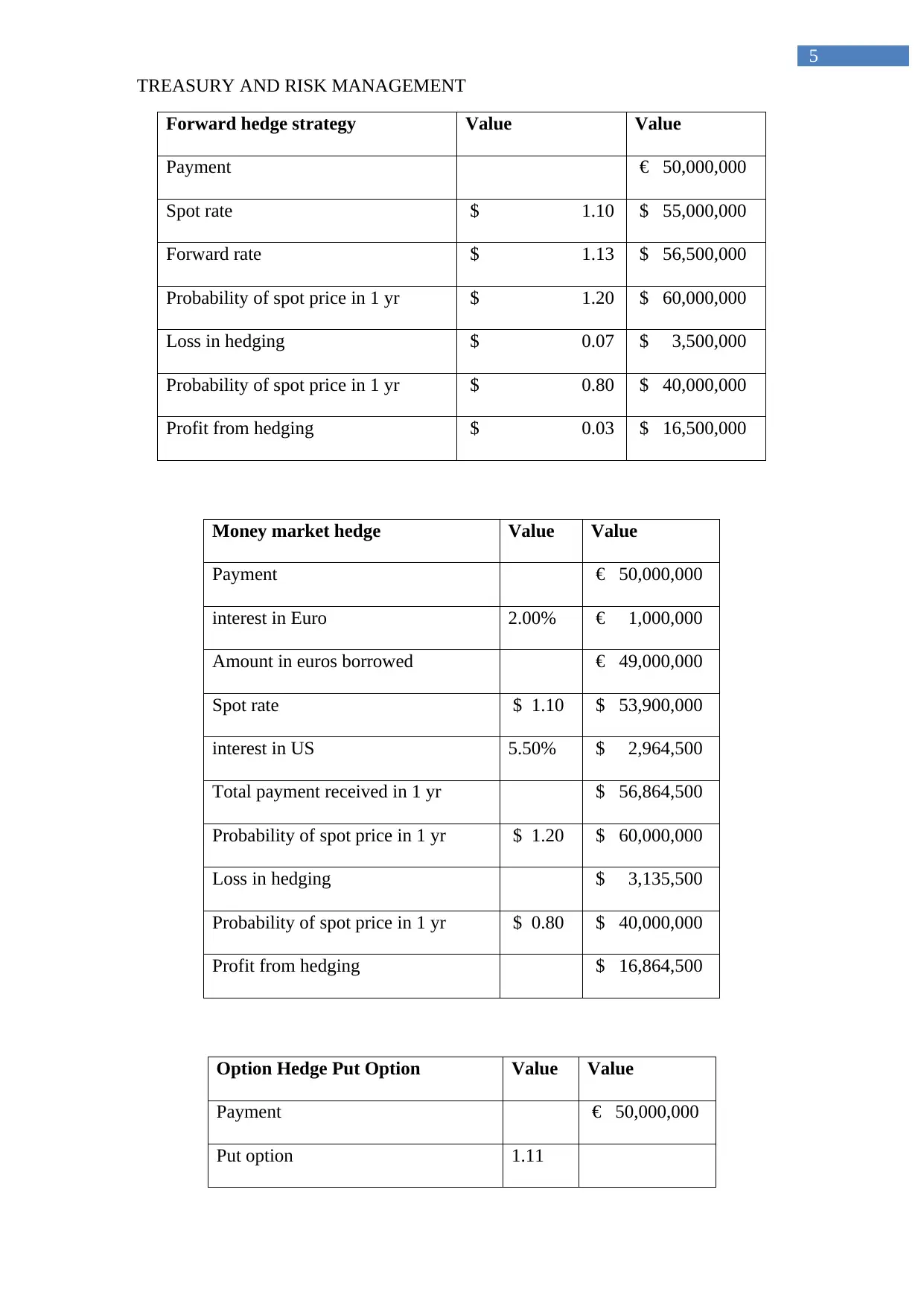
TREASURY AND RISK MANAGEMENT
5
Forward hedge strategy Value Value
Payment € 50,000,000
Spot rate $ 1.10 $ 55,000,000
Forward rate $ 1.13 $ 56,500,000
Probability of spot price in 1 yr $ 1.20 $ 60,000,000
Loss in hedging $ 0.07 $ 3,500,000
Probability of spot price in 1 yr $ 0.80 $ 40,000,000
Profit from hedging $ 0.03 $ 16,500,000
Money market hedge Value Value
Payment € 50,000,000
interest in Euro 2.00% € 1,000,000
Amount in euros borrowed € 49,000,000
Spot rate $ 1.10 $ 53,900,000
interest in US 5.50% $ 2,964,500
Total payment received in 1 yr $ 56,864,500
Probability of spot price in 1 yr $ 1.20 $ 60,000,000
Loss in hedging $ 3,135,500
Probability of spot price in 1 yr $ 0.80 $ 40,000,000
Profit from hedging $ 16,864,500
Option Hedge Put Option Value Value
Payment € 50,000,000
Put option 1.11
5
Forward hedge strategy Value Value
Payment € 50,000,000
Spot rate $ 1.10 $ 55,000,000
Forward rate $ 1.13 $ 56,500,000
Probability of spot price in 1 yr $ 1.20 $ 60,000,000
Loss in hedging $ 0.07 $ 3,500,000
Probability of spot price in 1 yr $ 0.80 $ 40,000,000
Profit from hedging $ 0.03 $ 16,500,000
Money market hedge Value Value
Payment € 50,000,000
interest in Euro 2.00% € 1,000,000
Amount in euros borrowed € 49,000,000
Spot rate $ 1.10 $ 53,900,000
interest in US 5.50% $ 2,964,500
Total payment received in 1 yr $ 56,864,500
Probability of spot price in 1 yr $ 1.20 $ 60,000,000
Loss in hedging $ 3,135,500
Probability of spot price in 1 yr $ 0.80 $ 40,000,000
Profit from hedging $ 16,864,500
Option Hedge Put Option Value Value
Payment € 50,000,000
Put option 1.11
⊘ This is a preview!⊘
Do you want full access?
Subscribe today to unlock all pages.

Trusted by 1+ million students worldwide
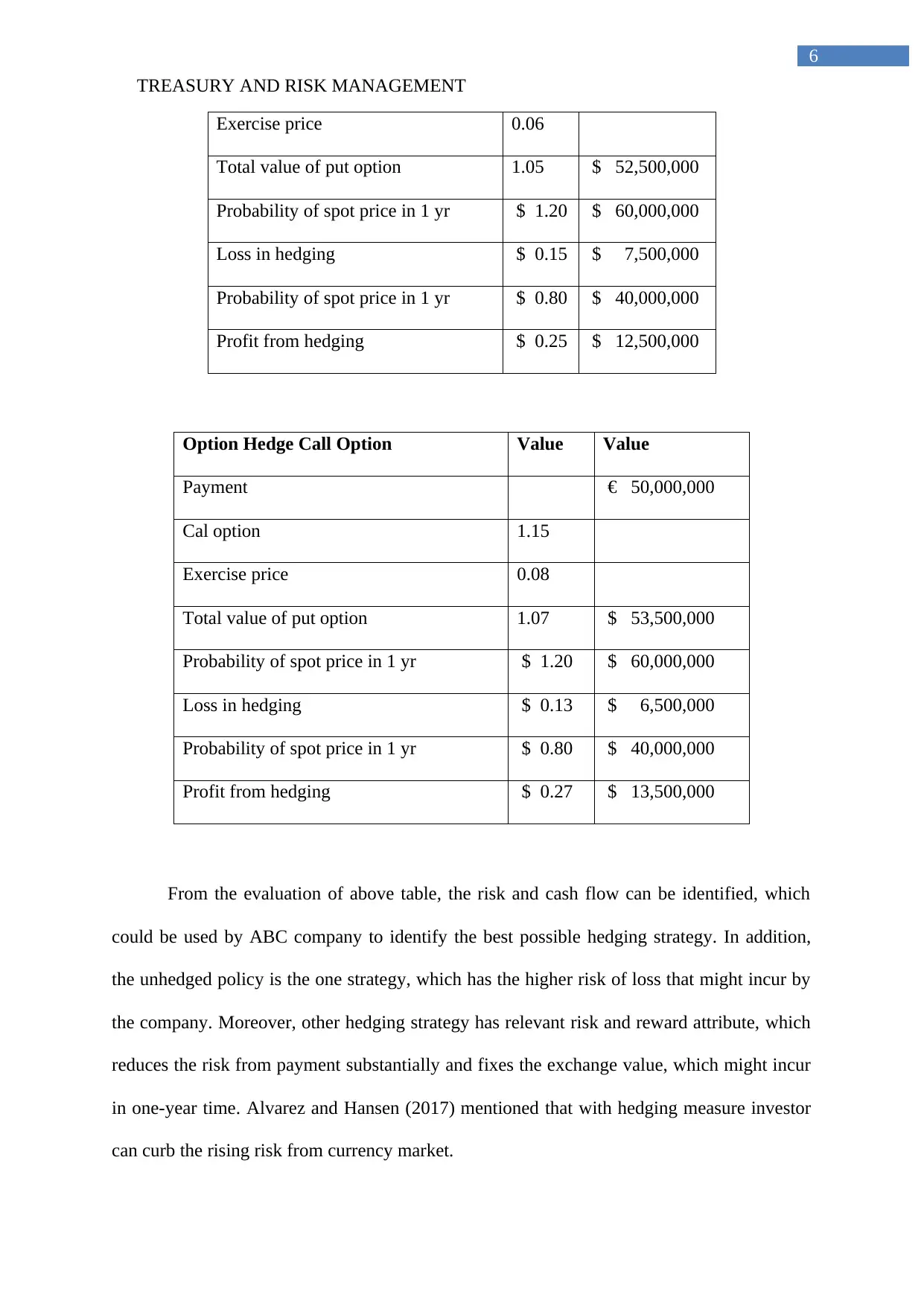
TREASURY AND RISK MANAGEMENT
6
Exercise price 0.06
Total value of put option 1.05 $ 52,500,000
Probability of spot price in 1 yr $ 1.20 $ 60,000,000
Loss in hedging $ 0.15 $ 7,500,000
Probability of spot price in 1 yr $ 0.80 $ 40,000,000
Profit from hedging $ 0.25 $ 12,500,000
Option Hedge Call Option Value Value
Payment € 50,000,000
Cal option 1.15
Exercise price 0.08
Total value of put option 1.07 $ 53,500,000
Probability of spot price in 1 yr $ 1.20 $ 60,000,000
Loss in hedging $ 0.13 $ 6,500,000
Probability of spot price in 1 yr $ 0.80 $ 40,000,000
Profit from hedging $ 0.27 $ 13,500,000
From the evaluation of above table, the risk and cash flow can be identified, which
could be used by ABC company to identify the best possible hedging strategy. In addition,
the unhedged policy is the one strategy, which has the higher risk of loss that might incur by
the company. Moreover, other hedging strategy has relevant risk and reward attribute, which
reduces the risk from payment substantially and fixes the exchange value, which might incur
in one-year time. Alvarez and Hansen (2017) mentioned that with hedging measure investor
can curb the rising risk from currency market.
6
Exercise price 0.06
Total value of put option 1.05 $ 52,500,000
Probability of spot price in 1 yr $ 1.20 $ 60,000,000
Loss in hedging $ 0.15 $ 7,500,000
Probability of spot price in 1 yr $ 0.80 $ 40,000,000
Profit from hedging $ 0.25 $ 12,500,000
Option Hedge Call Option Value Value
Payment € 50,000,000
Cal option 1.15
Exercise price 0.08
Total value of put option 1.07 $ 53,500,000
Probability of spot price in 1 yr $ 1.20 $ 60,000,000
Loss in hedging $ 0.13 $ 6,500,000
Probability of spot price in 1 yr $ 0.80 $ 40,000,000
Profit from hedging $ 0.27 $ 13,500,000
From the evaluation of above table, the risk and cash flow can be identified, which
could be used by ABC company to identify the best possible hedging strategy. In addition,
the unhedged policy is the one strategy, which has the higher risk of loss that might incur by
the company. Moreover, other hedging strategy has relevant risk and reward attribute, which
reduces the risk from payment substantially and fixes the exchange value, which might incur
in one-year time. Alvarez and Hansen (2017) mentioned that with hedging measure investor
can curb the rising risk from currency market.
Paraphrase This Document
Need a fresh take? Get an instant paraphrase of this document with our AI Paraphraser
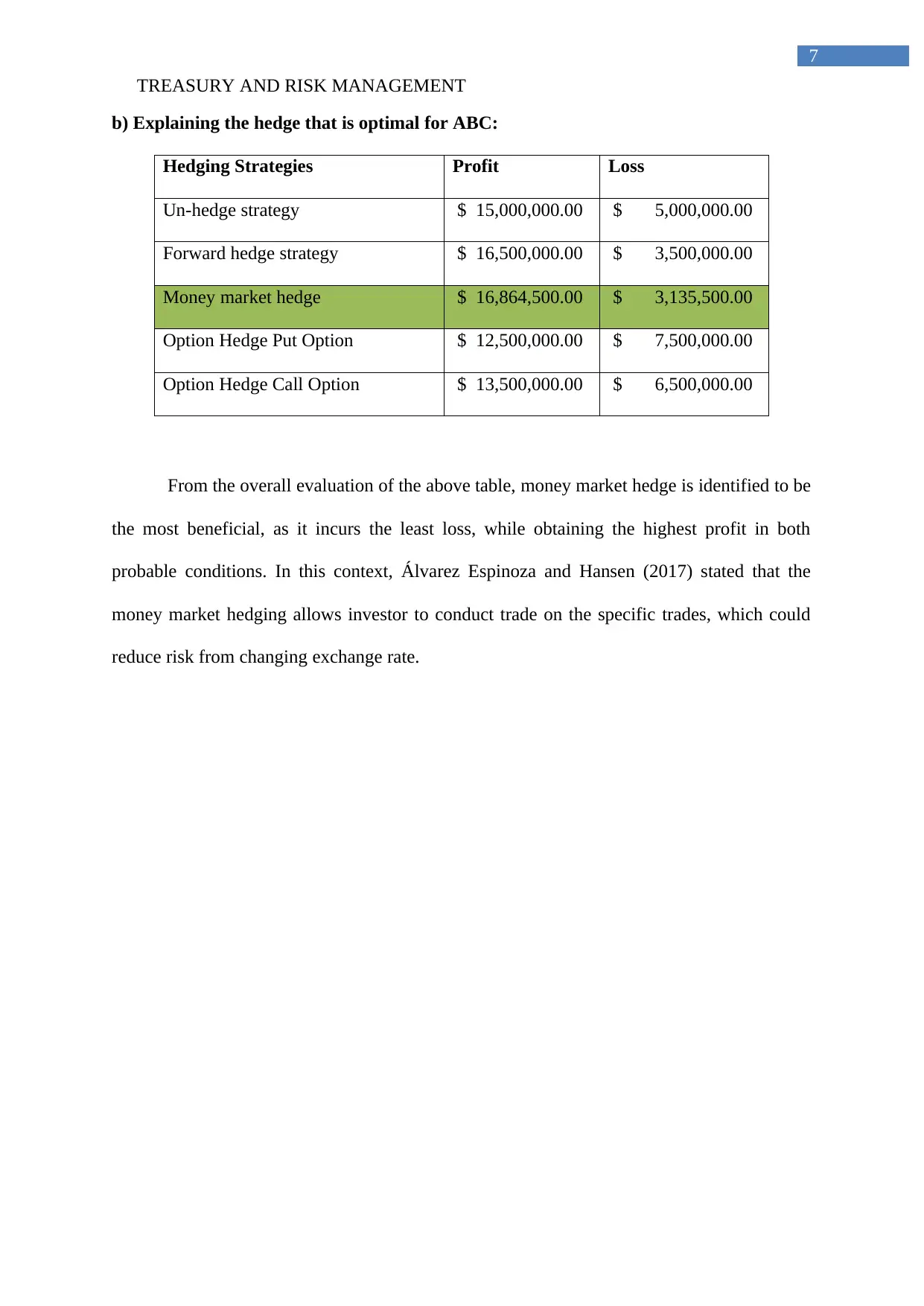
TREASURY AND RISK MANAGEMENT
7
b) Explaining the hedge that is optimal for ABC:
Hedging Strategies Profit Loss
Un-hedge strategy $ 15,000,000.00 $ 5,000,000.00
Forward hedge strategy $ 16,500,000.00 $ 3,500,000.00
Money market hedge $ 16,864,500.00 $ 3,135,500.00
Option Hedge Put Option $ 12,500,000.00 $ 7,500,000.00
Option Hedge Call Option $ 13,500,000.00 $ 6,500,000.00
From the overall evaluation of the above table, money market hedge is identified to be
the most beneficial, as it incurs the least loss, while obtaining the highest profit in both
probable conditions. In this context, Álvarez Espinoza and Hansen (2017) stated that the
money market hedging allows investor to conduct trade on the specific trades, which could
reduce risk from changing exchange rate.
7
b) Explaining the hedge that is optimal for ABC:
Hedging Strategies Profit Loss
Un-hedge strategy $ 15,000,000.00 $ 5,000,000.00
Forward hedge strategy $ 16,500,000.00 $ 3,500,000.00
Money market hedge $ 16,864,500.00 $ 3,135,500.00
Option Hedge Put Option $ 12,500,000.00 $ 7,500,000.00
Option Hedge Call Option $ 13,500,000.00 $ 6,500,000.00
From the overall evaluation of the above table, money market hedge is identified to be
the most beneficial, as it incurs the least loss, while obtaining the highest profit in both
probable conditions. In this context, Álvarez Espinoza and Hansen (2017) stated that the
money market hedging allows investor to conduct trade on the specific trades, which could
reduce risk from changing exchange rate.
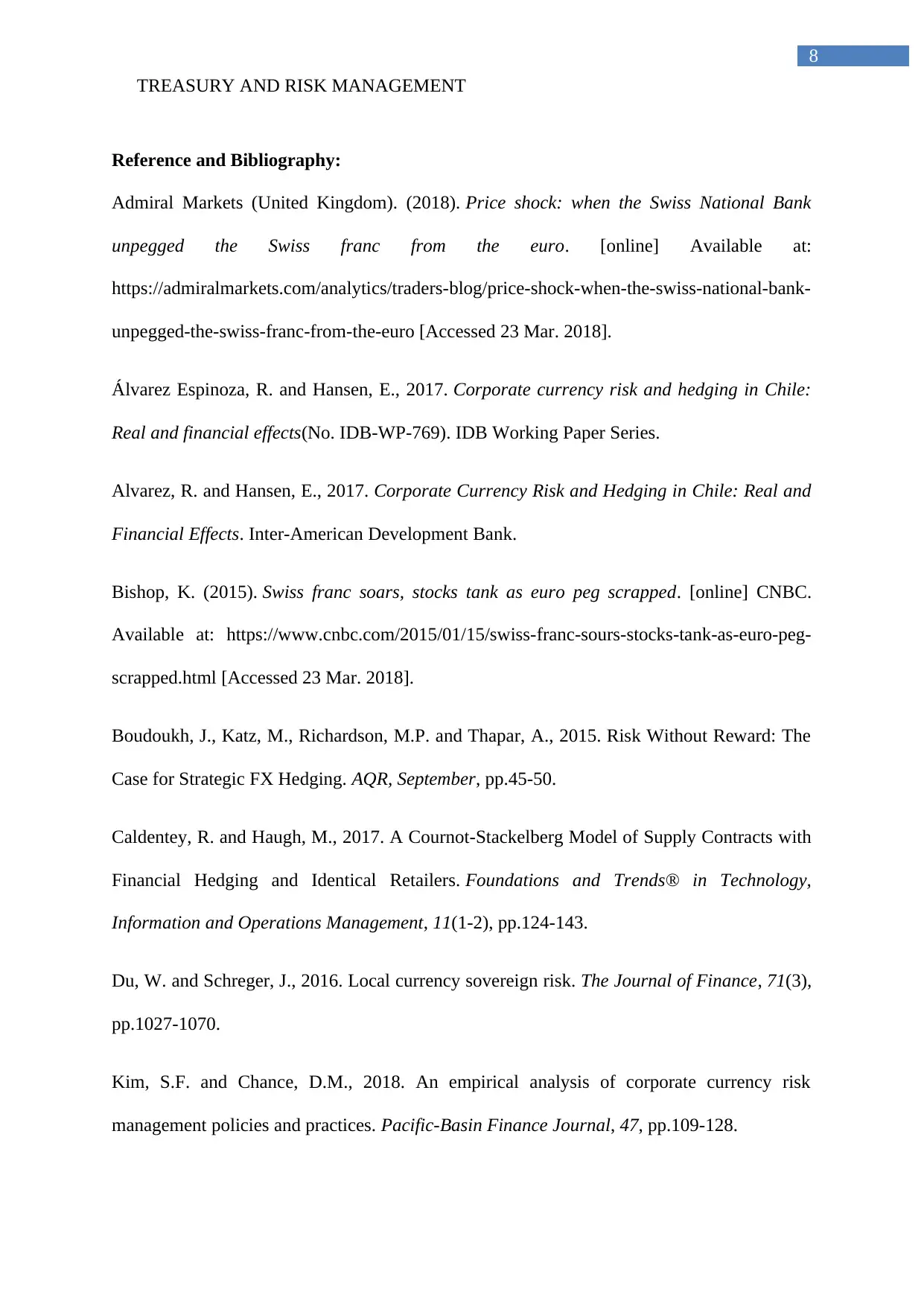
TREASURY AND RISK MANAGEMENT
8
Reference and Bibliography:
Admiral Markets (United Kingdom). (2018). Price shock: when the Swiss National Bank
unpegged the Swiss franc from the euro. [online] Available at:
https://admiralmarkets.com/analytics/traders-blog/price-shock-when-the-swiss-national-bank-
unpegged-the-swiss-franc-from-the-euro [Accessed 23 Mar. 2018].
Álvarez Espinoza, R. and Hansen, E., 2017. Corporate currency risk and hedging in Chile:
Real and financial effects(No. IDB-WP-769). IDB Working Paper Series.
Alvarez, R. and Hansen, E., 2017. Corporate Currency Risk and Hedging in Chile: Real and
Financial Effects. Inter-American Development Bank.
Bishop, K. (2015). Swiss franc soars, stocks tank as euro peg scrapped. [online] CNBC.
Available at: https://www.cnbc.com/2015/01/15/swiss-franc-sours-stocks-tank-as-euro-peg-
scrapped.html [Accessed 23 Mar. 2018].
Boudoukh, J., Katz, M., Richardson, M.P. and Thapar, A., 2015. Risk Without Reward: The
Case for Strategic FX Hedging. AQR, September, pp.45-50.
Caldentey, R. and Haugh, M., 2017. A Cournot-Stackelberg Model of Supply Contracts with
Financial Hedging and Identical Retailers. Foundations and Trends® in Technology,
Information and Operations Management, 11(1-2), pp.124-143.
Du, W. and Schreger, J., 2016. Local currency sovereign risk. The Journal of Finance, 71(3),
pp.1027-1070.
Kim, S.F. and Chance, D.M., 2018. An empirical analysis of corporate currency risk
management policies and practices. Pacific-Basin Finance Journal, 47, pp.109-128.
8
Reference and Bibliography:
Admiral Markets (United Kingdom). (2018). Price shock: when the Swiss National Bank
unpegged the Swiss franc from the euro. [online] Available at:
https://admiralmarkets.com/analytics/traders-blog/price-shock-when-the-swiss-national-bank-
unpegged-the-swiss-franc-from-the-euro [Accessed 23 Mar. 2018].
Álvarez Espinoza, R. and Hansen, E., 2017. Corporate currency risk and hedging in Chile:
Real and financial effects(No. IDB-WP-769). IDB Working Paper Series.
Alvarez, R. and Hansen, E., 2017. Corporate Currency Risk and Hedging in Chile: Real and
Financial Effects. Inter-American Development Bank.
Bishop, K. (2015). Swiss franc soars, stocks tank as euro peg scrapped. [online] CNBC.
Available at: https://www.cnbc.com/2015/01/15/swiss-franc-sours-stocks-tank-as-euro-peg-
scrapped.html [Accessed 23 Mar. 2018].
Boudoukh, J., Katz, M., Richardson, M.P. and Thapar, A., 2015. Risk Without Reward: The
Case for Strategic FX Hedging. AQR, September, pp.45-50.
Caldentey, R. and Haugh, M., 2017. A Cournot-Stackelberg Model of Supply Contracts with
Financial Hedging and Identical Retailers. Foundations and Trends® in Technology,
Information and Operations Management, 11(1-2), pp.124-143.
Du, W. and Schreger, J., 2016. Local currency sovereign risk. The Journal of Finance, 71(3),
pp.1027-1070.
Kim, S.F. and Chance, D.M., 2018. An empirical analysis of corporate currency risk
management policies and practices. Pacific-Basin Finance Journal, 47, pp.109-128.
⊘ This is a preview!⊘
Do you want full access?
Subscribe today to unlock all pages.

Trusted by 1+ million students worldwide
1 out of 9
Related Documents
Your All-in-One AI-Powered Toolkit for Academic Success.
+13062052269
info@desklib.com
Available 24*7 on WhatsApp / Email
![[object Object]](/_next/static/media/star-bottom.7253800d.svg)
Unlock your academic potential
Copyright © 2020–2025 A2Z Services. All Rights Reserved. Developed and managed by ZUCOL.




